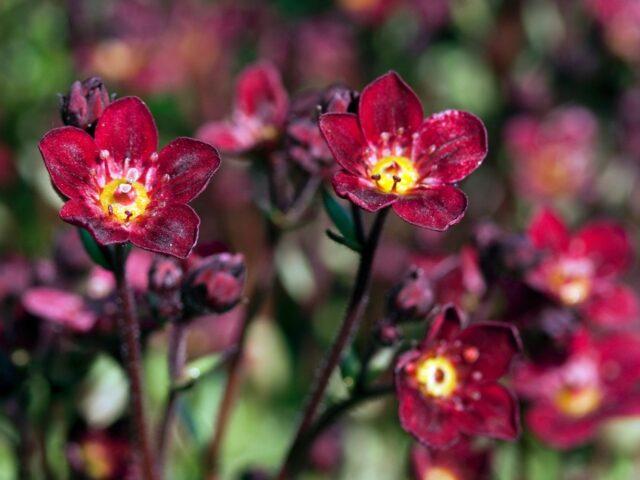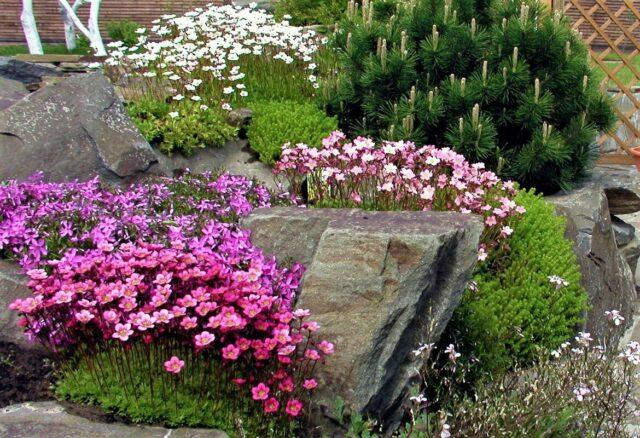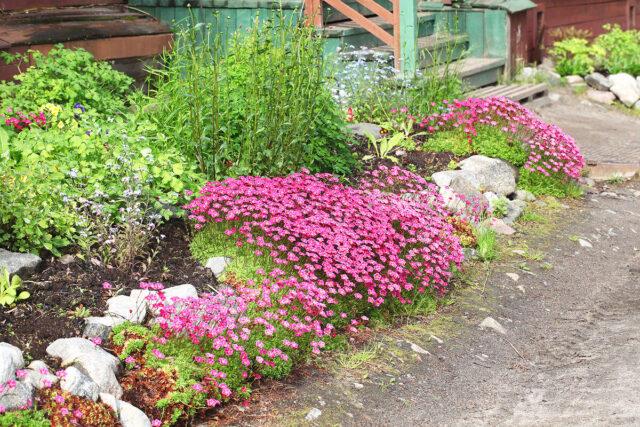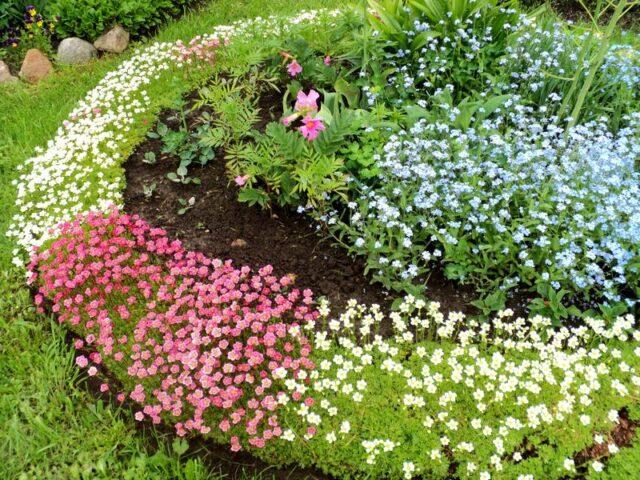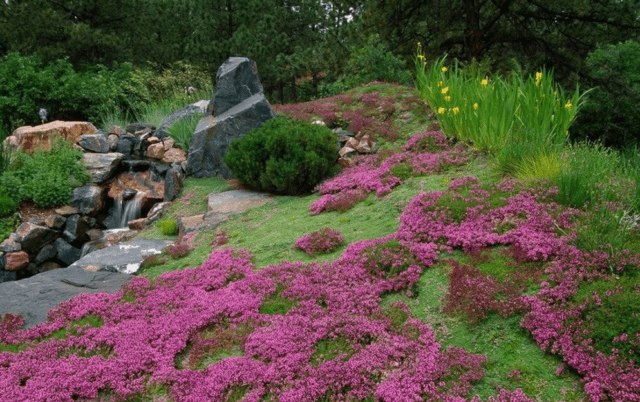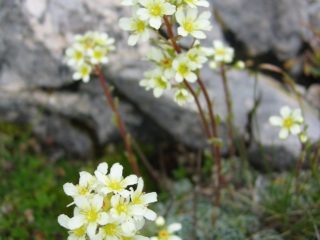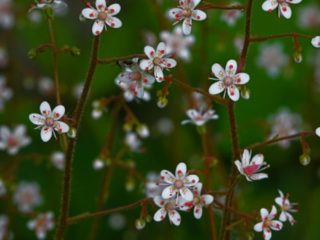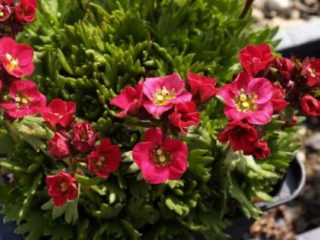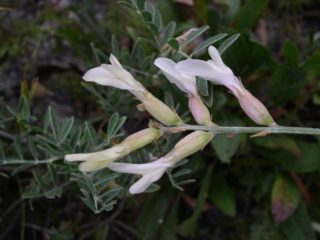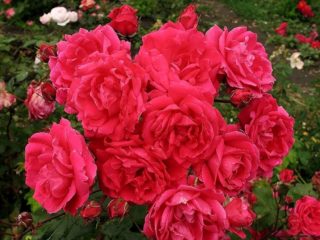Content
- 1 What does a saxifrage look like?
- 2 Types and varieties of saxifrage with photos
- 3 Saxifrage in landscape design
- 4 Useful properties of saxifrage
- 5 Conclusion
Garden saxifrage is a beautiful plant, represented by a wide variety of species and varieties. Summer residents appreciate the perennial not only for its decorative effect, but also for its useful properties.
What does a saxifrage look like?
Saxifrage is a herbaceous perennial plant from the Saxifrage family. In height, it usually rises by 5-70 cm, has a developed rhizome. The rosette of leaves at the very surface of the earth grows to the sides and forms a dense hemispherical turf. Plates can be oval, heart and diamond-shaped, dark green, bluish or silver, depending on the variety.
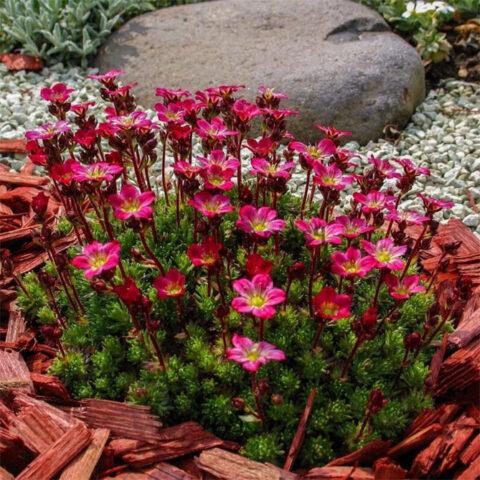
Saxifrage peduncles noticeably rise above the rosettes of leaves
A photo of perennial saxifrage shows that it blooms with small, star-shaped five-petalled buds, usually collected in panicles. The color can be white, yellow or pink, the decorative period lasts from early summer to autumn.
Types and varieties of saxifrage with photos
Before choosing a plant for a summer cottage, you need to study the types of saxifrage, varieties and photos with names. Perennials differ among themselves in size, shape of leaves and shades of inflorescences.
Thigh
Saxifrage thigh (Pimpinella saxifrage) is a herbaceous plant up to 60 cm tall. It has a hollow, straight stem with slight pubescence; from the beginning of summer, umbrella-shaped inflorescences of a white or pinkish hue appear on the tops. In the photo of the Bedrenets saxifrage, it can be seen that the shields consist of about twelve separate buds.
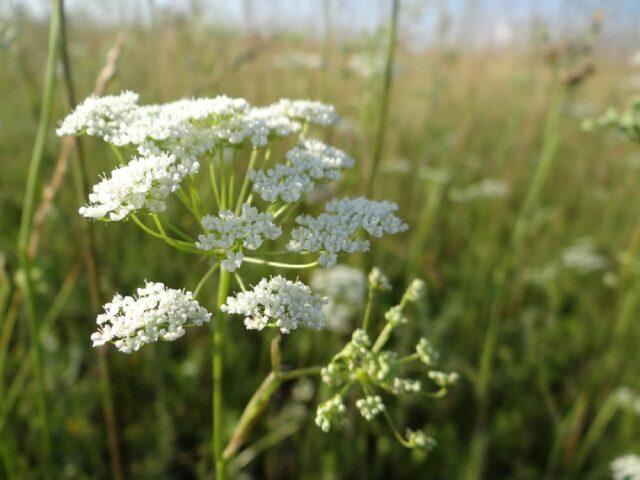
The thigh has dimensions and shape atypical for saxifrage
Manchu
Manchurian saxifrage (Saxifraga manchuriensis) is a dwarf plant with shoots about 45 cm tall. A powerful basal rosette consists of dense dark green rounded leaves, the flowers of the species are white-pink. The period of decorativeness begins at the end of July, the buds, collected in capitate inflorescences, retain their attractiveness for about one and a half months.
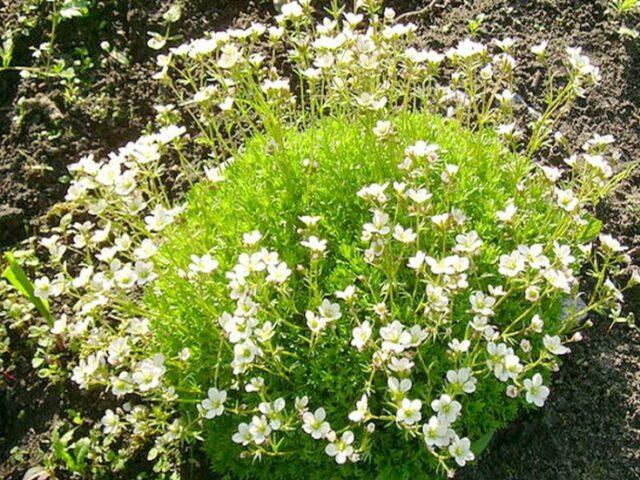
Manchurian saxifrage has high frost resistance
Grainy
Granular saxifrage (Saxifraga granulate) is a plant with straight pubescent stems up to 40 cm high. At the base of the basal rosette, a small tuber is noticeable, the leaves of the perennial are sessile, dissected, dark green. The species blooms in early summer, brings white buds, united in loose brushes. Remains attractive for about two months.

Granular saxifrage has a mild almond odor
Round-leaved
The round-leaved saxifrage (Saxifraga rotundifolia) has thin branching stems with round small leaves of a dark green hue. The flowers of the species are small, porcelain white, with red blotches on the petals. The plant is especially appreciated by gardeners for a long decorative period - from early summer to autumn. Flowering is very lush and abundant.
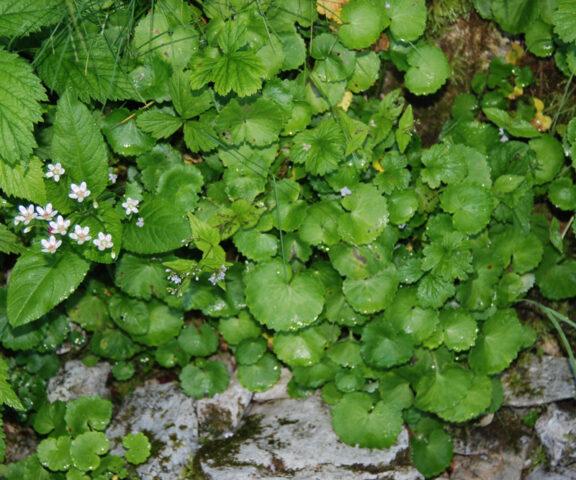
Round-leaved saxifrage well tolerates shade and winter frost
Opposite-leaved
The opposite-leaved saxifrage (Saxifraga oppositifolia) has small emerald leaves arranged in pairs. Creeping stems reach 15 cm in length, the species is characterized by very early spring flowering. The plant produces small pink-red buds that turn purple as they develop. Grows well and can form lush turf.
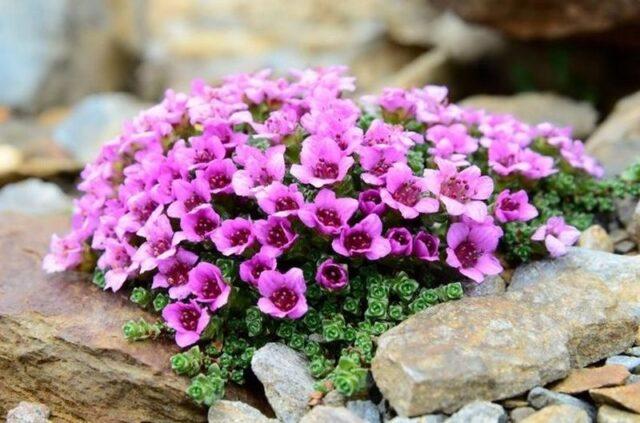
The opposite-leaved saxifrage grows well in the north, but hardly tolerates the warm climate
Urban (shadow)
The urban saxifraga (Saxifraga urbium) rises no higher than 15 cm above the ground and forms a continuous carpet. The leaves of the plant are oblong, but wide, with a jagged edge. Buds are small, light pink, united in loose panicles. The peculiarities of the variety include early flowering - from late May to early July.
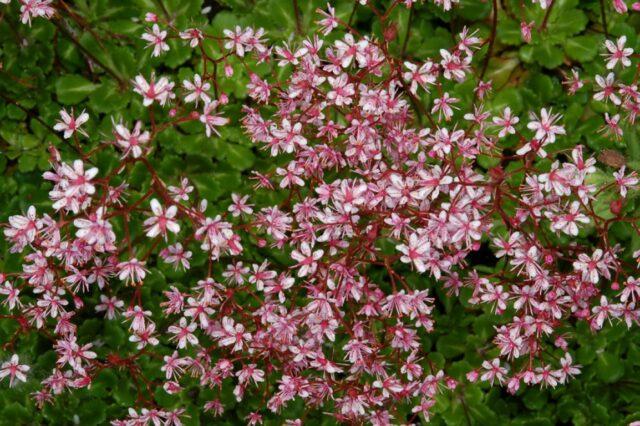
Unlike many other species, the urban saxifrage winters well in the middle lane.
Reed
Lingulate saxifrage (Saxifraga lingulata) is a perennial plant up to 35 cm. Green leaves, collected in a rosette, have a light edge. The buds of the variety are white, forming drooping openwork inflorescences. It reaches its maximum decorative effect in July, and can retain its beauty until autumn.
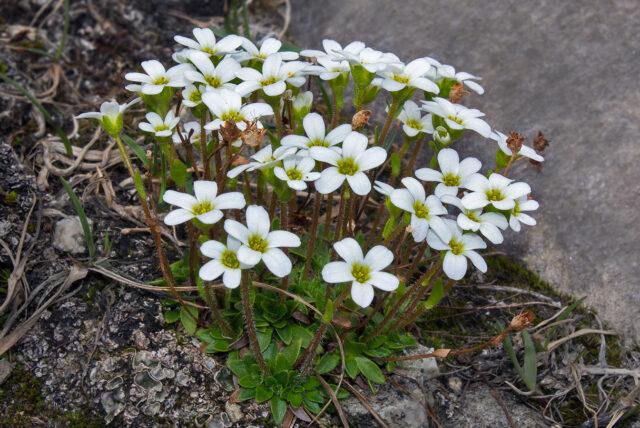
Reed saxifrage is planted both in the sun and in the shade, white buds look equally good
Soddy
Soddy saxifrage (Saxifraga cespitosa) is common in Eurasia and North America. The stems of a plant up to 20 cm tall are pubescent and straight, the flowers are usually white, yellowish or greenish. The decorative period begins in June and can last all summer, the species is unpretentious and resistant to low temperatures.
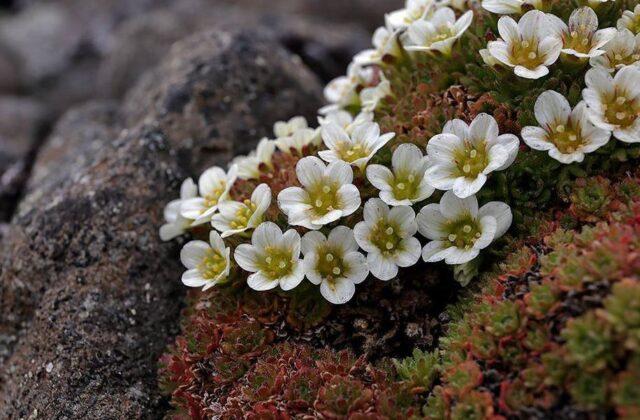
In some regions of Russia, soddy saxifrage is listed in the Red Book
Juniper
The juniper saxifrage (Saxifraga juniperifolia) has thin leaves that resemble pine needles. The plant is compact, up to 15 cm in height, in a single planting it resembles a small dark green thorny hummock. Brings spike-shaped yellow flowers, blooms in late May or early June.

Juniper-leaved saxifrage looks good in rocky gardens next to conifers
Hawk-leaved
The hawk-leaved saxifrage (Saxifraga hieracifolia) rises on average up to 50 cm above the ground. The leaves of the plant are thick, with a serrated edge and pubescence in the lower part. The flowers are greenish or reddish, bloom quite late - in July and August.
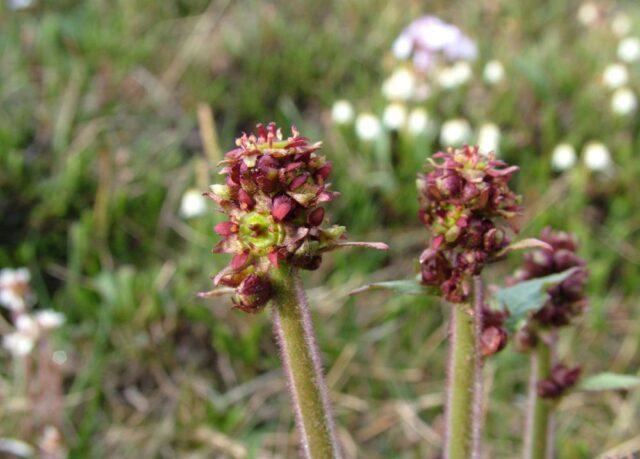
Hawk-leaved saxifrage is not very decorative and is not in great demand among gardeners
Evergreen
Evergreen saxifrage (Saxifraga paniculata) belongs to the dwarf species and rises only up to 8 cm above the ground. Forms a dense carpet with abundant growth. The leaves are fleshy, bluish green and toothed, the flowers are usually white. The plant blooms closer to the middle of summer.
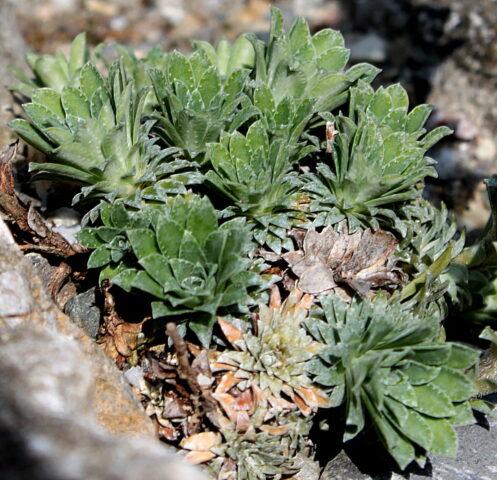
Evergreen saxifrage keeps its leaves bright even in the cold season
Snowy
Snow saxifrage (Saxifraga nivalis) is one of the most hardy species. Rises on average 20 cm above the ground. The flowers of the plant are rather inconspicuous - with white petals and a green base. It acquires maximum decorative effect from mid-June and retains it for about a month.
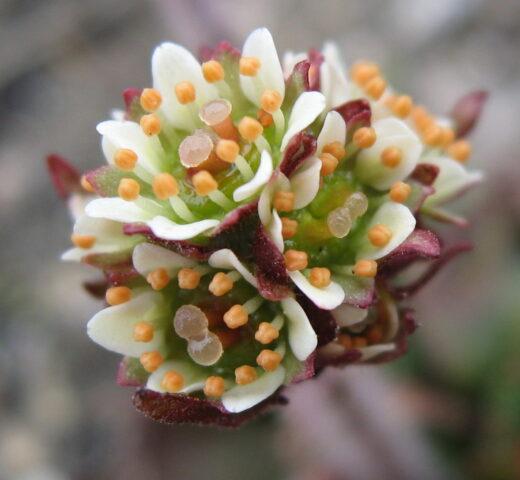
Snow saxifrage feels comfortable in arctic climates
Arends' saxifrage
Arends' saxifrage (Saxifraga arendsii) is the most common interspecific hybrid among gardeners. Plants usually grow no more than 20 cm and produce pinkish or white flowers. They become decorative from late spring to mid-summer.
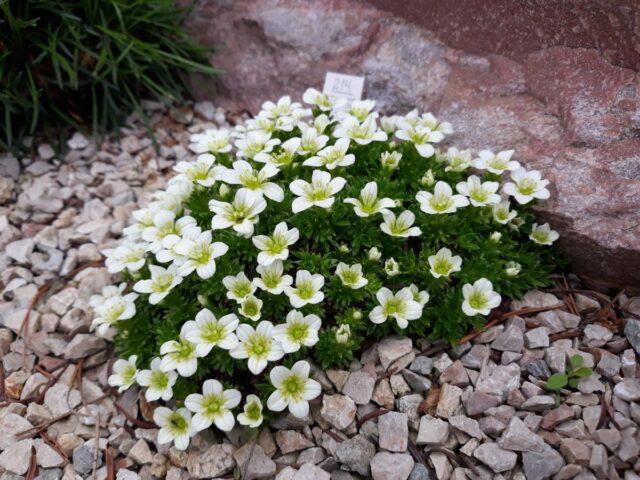
Arends' saxifrage is represented by numerous decorative varieties
The best varieties
Not all saxifrage are popular with summer residents and flower growers, but only the most beautiful of them.Usually we are talking about artificially bred hybrid varieties, they combine attractiveness and ease of care.
Ice Queen
The decorative variety Ice Queen has elongated leaves with a silvery-green color. The flowers of the plant are snow-white, appear on the shoots at standard times in early summer. Perennial grows very quickly, tolerates negative temperatures well.
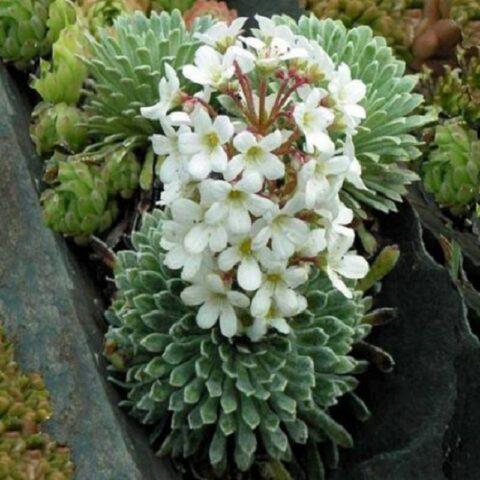
You can grow Ice Queen on the site without winter shelter
Purplemantel
Saxifrage Purpurmantel is a frost-resistant ground cover variety for decorating alpine hills and low walls. Rises up to 20 cm above the ground, forms a dense carpet of basal leaves. In late spring, it produces medium-sized purple-pink flowers.
Purple robe
Hybrid saxifrage Purple Robe grows on average up to 15 cm above ground level. The flowering of the variety begins in late May, the buds are dark, carmine-red. Perennial looks harmoniously in rocky gardens next to other low-growing plants, unpretentious in care.

Saxifrage Purple mantle retains decorative effect from early spring to snow cover
Flower carpet
The Floral Carpet variety can grow up to 20 cm in height. Differs in a variegated flowering of pink, white and purple hues. It grows profusely in all directions, prefers well-lit areas, but calmly tolerates a small shadow.
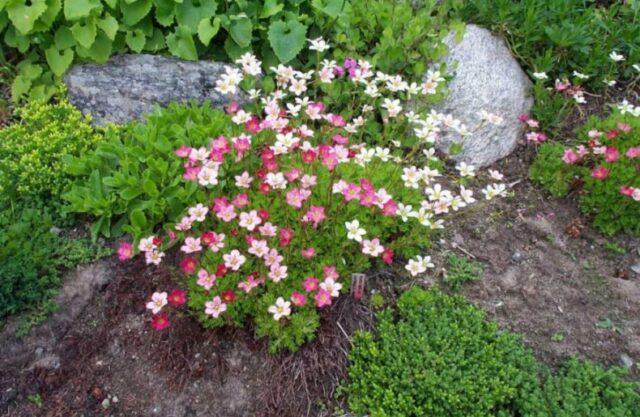
The Flower Carpet variety enters the decorative period at the end of spring.
Pink carpet
Carpet Pink is only about 7 cm high. Looks good in mixed compositions among other miniature plants, often grown in rocky gardens. Perennial flowering occurs in early summer, the buds are dark pink and very abundant.
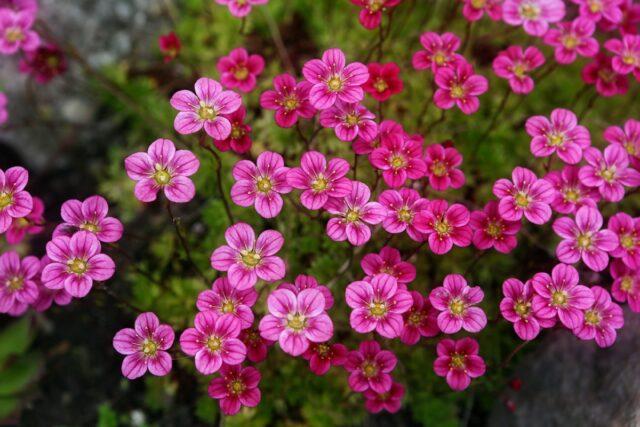
Pink carpet can be grown in the middle lane and northern region
Purple carpet
Carpet Purple reaches 15 cm above the ground. The leaves of the perennial are green, collected in dense rosettes, purple flowers up to 4 cm in diameter. Blossoms in May and June, thrives best in partial shade on wet soil.
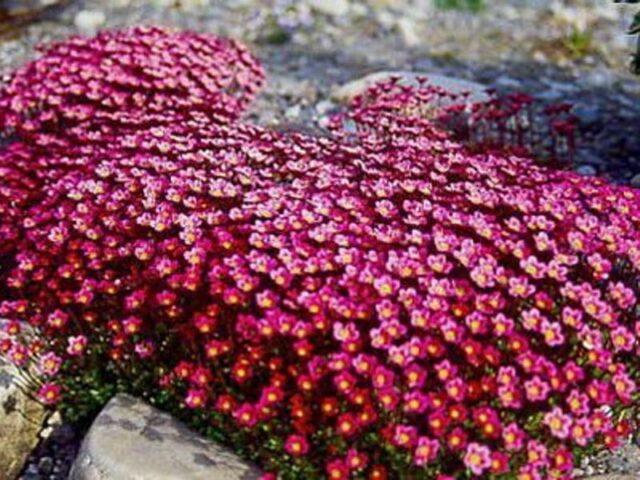
Saxifrage Purple carpet tolerates frost well and requires only cover with a layer of foliage
Snow carpet
The variety Snow Carpet (Carpet White) densely covers the soil in the designated area. It grows on average up to 20 cm, blooms from May to early July. As the name implies, the buds are snow-white; during the decorative period, the plant looks very impressive. The white saxifrage prefers well-moistened soils, likes illuminated areas.
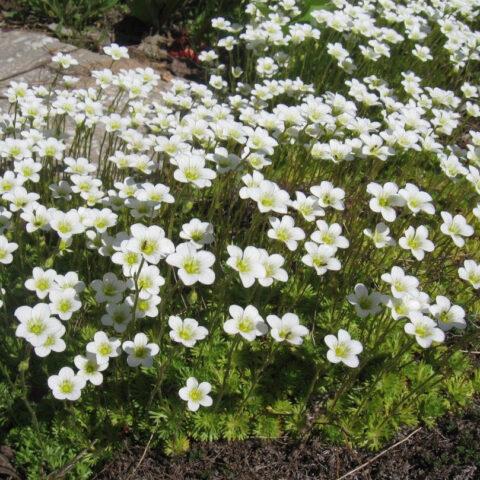
The Snow Carpet variety does not require shelter for the winter
Tricolor
The Tricolor variety is distinguished by variegated foliage - green with a wide white-pink border. The shoots of the plant are long, climbing, up to 60 cm. The flowers are rather modest, reddish or snow-white in loose panicles. Basically, the variety is valued precisely for its ornamental leaves.
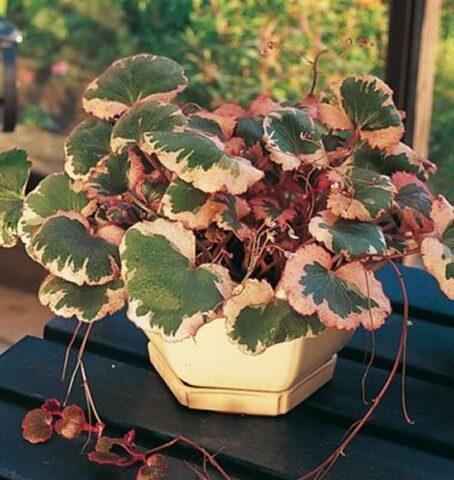
The saxifrage Tricolor is often bred as an ampelous plant.
Rosea
Rosea (Rosea) reaches 20 cm in height and forms dense thickets of lobed leaves collected in rosettes. The shoots of the plant are thin, in May and June large pink flowers appear on them.
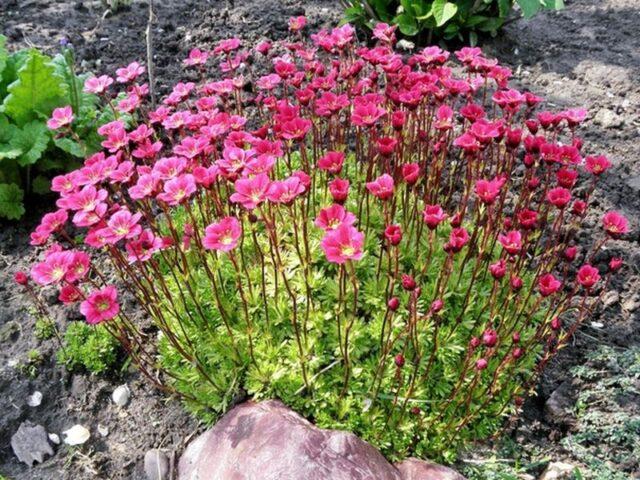
Rosy's saxifrage is often used in rock gardens in semi-shaded areas.
Harvest Moon
Harvest Moon is a compact saxifrage up to 30 cm tall with a yellow-green color of pubescent leaves. In May and June, it bears stellate flowers with elongated white petals. Due to the unusual color of the foliage, it retains its decorative effect even after the buds have fallen off.

The original Harvest Moon variety can be grown in the middle lane and in the south
Schneeteppich
Hybrid saxifrage Schneeteppich grows on average 15 cm above the ground. The flowers of the plant are star-shaped, pure white and quite beautiful. The perennial blooms in late spring or early summer, retains its maximum beauty for about one and a half months.
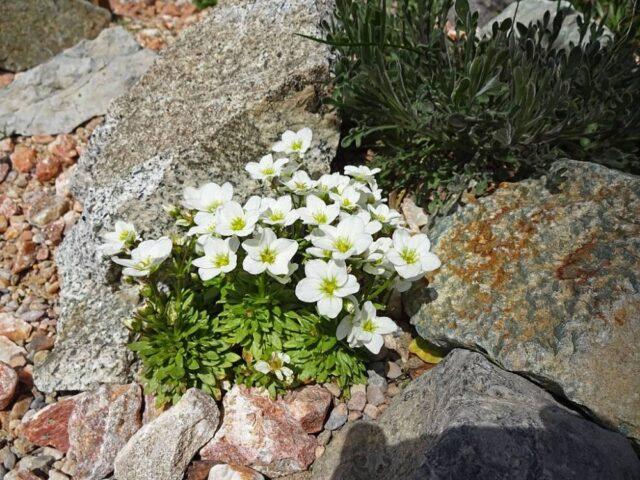
The Schneeteppich variety looks especially impressive in well-lit areas.
Blutenteppich
The Bluttnteppich saxifrage rises only 12 cm above the ground. In early summer, it brings bright pink-red buds, is capable of forming a low dense carpet in a rocky garden or rock garden. It goes well with lighter undersized plants.
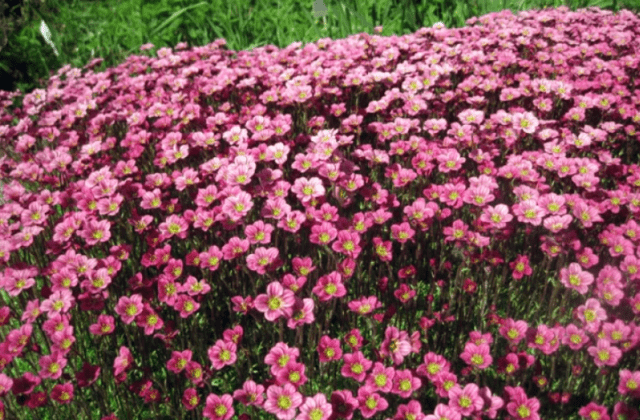
In winter, the Blutenteppih variety requires shelter - its frost resistance is average
Variegata
Saxifrage Variegata is a ground cover variety up to 30 cm above ground level. The leaves of the plant are wide, green with yellow stripes, spatulate. The rosette can reach 8 cm in diameter. The perennial blooms in June, its buds are white with pink hearts.
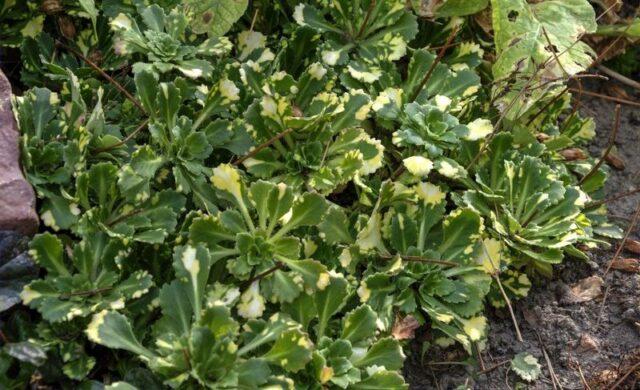
The contrasting leaves of the variegat saxifrage look especially advantageous in the sun.
Flamingo
The Flamingo saxifrage reaches 15 cm in height, acquires its maximum decorative effect at the end of spring. The flowers of the plant are pink, they look attractive both in the light and in the shade. It is appreciated by gardeners for its delicate shade of petals and endurance.
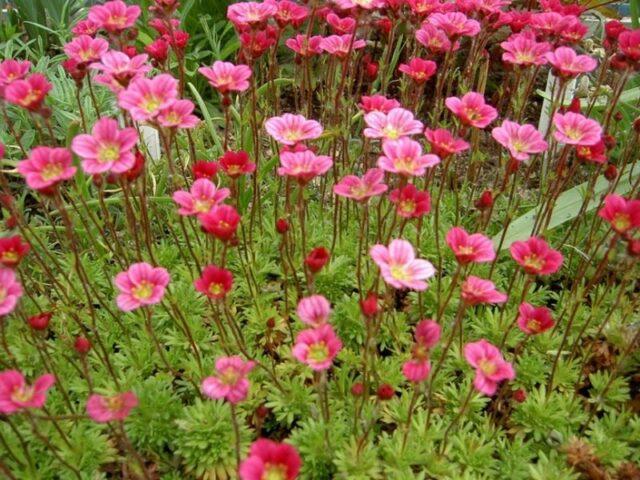
Flamingo saxifrage blooms continuously for about a month
Saxifrage in landscape design
The stunted garden saxifrage is most often used to create miniature compositions. You can usually see it:
- in rock gardens and rockeries;
The saxifrage thrives on stony soils
- in decorating borders;
With the help of a saxifrage, you can effectively emphasize the line of the path
- in artistic compositions;
Saxifrage is harmoniously combined with other perennials
- in the design of the banks of reservoirs;
Saxifrage not only decorates the coastal areas, but also prevents the slopes from crumbling.
Photos of saxifrage in landscape design show that the plant decorates and enlivens any space.
Useful properties of saxifrage
A perennial plant is appreciated not only for its beauty, but also for its many beneficial properties. Medicines based on it:
- have anti-inflammatory and antiseptic effects;
- help with high temperatures;
- used for otitis media and furunculosis;
- relieve inflammation and pain with ulcers, carbuncles and phlegmon;
- help relieve the course of hemorrhoids;
- are beneficial in treating diarrhea;
- have a beneficial effect on seizures.
Perennials can be used even in complex therapy for oncology.
The use of saxifrage herb in traditional medicine
For the treatment of diseases based on herbs, several medicinal products are prepared. In any of its forms, saxifrage has a positive effect on the body when used correctly.
Recipes
For the preparation of medicines, dried leaves and underground parts of a perennial plant are used:
- Tea... The saxifrage root must be thoroughly crushed, in the amount of a small spoon, brew in 250 ml of water and leave for about 20 minutes. They drink the remedy on a full stomach three times a day, you can add a little honey to the cup.
- Infusion... To create a medicinal drink, you need to grind half a large spoonful of plant roots, pour a glass of hot water and leave for three hours. Drink 100 ml of the product up to four times a day.
- Decoction... The drink is prepared from fresh leaves of the plant - in a volume of 30 g, they are boiled in 300 ml of boiling water in a water bath for 15 minutes. Then the product is cooled, filtered and added with clean liquid to its original volume. Take a drink in two large spoons four times a day on an empty stomach.
When using infusions and decoctions of a perennial plant, it is important to adhere to the recommended dosages. Active substances in roots and leaves in too large quantities can be harmful.
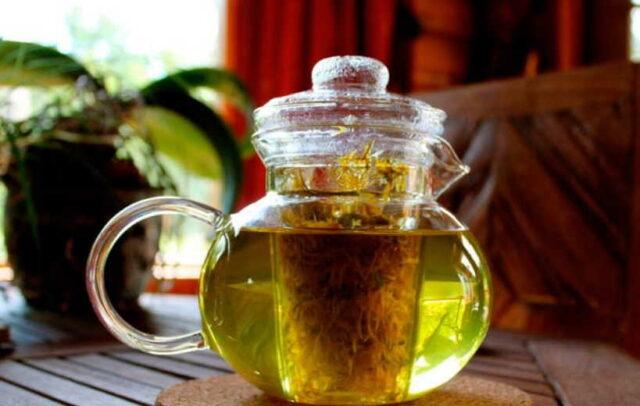
More valuable substances are concentrated in the roots of saxifrage than in the leaves
Application rules
Traditional medicine offers several recipes that can bring relief from acute and chronic diseases.The success of therapy depends on adherence to the norms and dosages of admission.
For kidney stones
With calculi in the kidneys, a strong tincture helps well. They do it like this:
- 100 g of dry roots are poured into 500 ml of vodka;
- clog the container and put it in a dark place for ten days;
- filter through cheesecloth.
You need to take medicine from saxifrage for kidney stones 30 drops up to five times a day on a full stomach. The tool relieves swelling well, removes excess fluids from the body and helps with small stones.
For gallstones
For cholecystitis, liver diseases and gallstones, it is recommended to take a decoction of a medicinal plant. The recipe looks like this:
- two large tablespoons of crushed leaves are poured into 300 ml of water;
- boil over low heat for 15 minutes;
- cooled under a lid and filtered through cheesecloth.
You need to take the ready-made broth in two large spoons shortly before eating.
With asthma and bronchitis
Saxifrage has a beneficial effect on asthma, coughs and tonsillitis. The remedy is prepared according to this recipe:
- a small spoonful of dry roots is poured into a glass of water;
- bring to a boil on the stove;
- immediately removed from the heat and cooled.
To improve the taste, natural honey is added to healthy tea. You need to take the drink three times a day on a full stomach.
With gout
The perennial plant helps remove uric acid deposits from the joints. The drug is prepared as follows:
- 20 g of leaves are poured with 200 ml of water;
- 15 minutes simmer the product in a water bath;
- for another 45 minutes, insist under the lid until cooled;
- filter through cheesecloth.
You need to take the broth after meals, 30 ml up to four times a day.
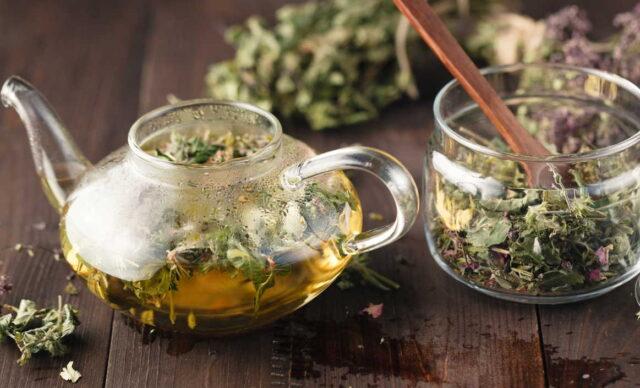
Herbal teas based on saxifrage help with rheumatism and arthrosis
With diseases of the gastrointestinal tract
The medicinal plant can improve the condition of gastritis, ulcers and pancreatitis in remission. For medicinal purposes, the following decoction is made:
- a large spoonful of dry roots is poured with 250 ml of boiling water;
- hold for ten minutes in a water bath;
- insist for another half hour.
The cooled agent is filtered, a spoonful of honey is added if desired and the drink is taken on an empty stomach, 70 ml three times a day.
Limitations and contraindications
The benefits and harms of a medicinal plant are not always the same. It is impossible to take decoctions and infusions based on perennials when:
- varicose veins and a tendency to thrombosis;
- individual allergies;
- bradycardia;
- hypotension.
During pregnancy, it is better to refuse from saxifrage Bedrenets, the same applies to breastfeeding, a perennial can provoke an allergy in a newborn. Plant-based products are not offered to children under seven years of age.
Conclusion
Garden saxifrage is a useful, very beautiful and unpretentious crop for growing conditions. There are many types and ornamental varieties of plants; for a summer cottage, you can choose only one of them or combine several at once.
